From Mario Kart to Fine Art

Video games like Final Fantasy and Call of Duty have focused more over the decades on creating realistic environments and characters for the player to experience. This is just one of the arguments for why videogames should be considered an art form.
December 11, 2017
On Nov. 29th, 2012, the Museum of Modern Art placed video games in an art museum. This sparked a resurgence of countless articles and videos challenging or defending whether video games qualified as a form of art. This article will attempt to delve into the qualifications of art, and take an objective approach at this increasingly pertinent topic of debate: The validity of video games as an art form.
The first elephant in the room to address is the presence of already-established art forms within the media of video games. Video games within themselves can contain almost any other form of art. There are soundtracks, cut-scenes (think mini-movies), voice-acting, and scripts within many of these games, which some gamers on online forums such as Reddit say are just as powerful as any other book, movie, or song. However, this is not inherently because of the merit of the games themselves. A song is a song whether put in a video game or a record. Artistic elements in video games do not make the video games themselves art.
The Oxford English Dictionary defines art as “the expression or application of human creative skill or imagination… producing works to be appreciated primarily for their beauty or emotional power.” One of the strongest arguments for why video games cannot be validated as art is that they take entire teams, sometimes consisting of hundreds of people, thus having the project not under one artistic vision. However, some unmistakable forms of art such as movies and architecture are very large collaborative efforts that are under the vision of one director or architect. Video games are no different in this regard.
The second part of the definition is a bit more complex: “producing works to be appreciated primarily for their beauty or emotional power.” Gamers and artists alike are questioning the ability of video games to offer beauty or emotional power, keeping in mind that this would be because of the game itself and not any other form of art within the video game? The growing consensus is: yes. There is an ever-flourishing genre of games that focus less on adrenaline and clear objectives and more on exploring serene environments, simply taking everything in. The interactivity with environments in video games is just one of countless largely unexplored ways video games have the opportunity to present completely new and unique ways to move the player emotionally.
Despite all of this, one word of the definition causes problems: “primarily.” Being art must be the game’s primary objective. That’s a big problem for the validation of video games as art, because most game developers would tell you that their games are supposed to be one thing first and foremost: fun. This can change. There are some games that might have crossed the boundary into the territory of art. What separates them from games that have not crossed this line is their intent. If a developer makes a game that he or she says is art, that does not necessarily make the game art, but it is a first step. The next step is to create a video game with that can fit the definition of art. If done right, this should not inhibit what video games can be but expand their possibilities to do what they’ve never been able to do before.













![Film Club meets every Friday in Mr. McCormicks room (1602) from 3:15 to 4:15 to watch and analyze films and connect with other students with similar interests. “My favorite part is just looking over at my friends [when] something crazy happens on screen and [being] kind of like “wait [what]’ and when people start yelling at the movie,” Faith Wallace, ‘24, said.](https://whhscbox.com/wp-content/uploads/2024/02/IMG_9711-600x400.jpg)





